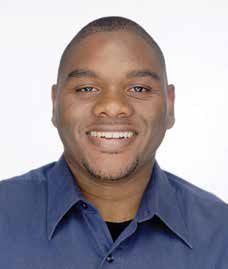The California Department of Corrections and Rehabilitation (CDCR) is the second-largest law enforcement agency (counted by staff) in the United States. CDCR’s Office of Correctional Education (OCE) is an integral part of the Division of Rehabilitative Programs (DRP), whose goal is to reduce the state’s prison population through education and rehabilitation programming. In his role, Frank Harrison serves as the subject matter expert for division’s Internet Protocol Television Integration (IPTVI) project, creating a central television network between headquarters and the institutions. Harrison is always learning, exploring new techniques and technologies that can improve UX and increase AV efficiencies. AV Technology editors were grateful to meet him at a recent AV/IT Leadership Summit and we were impressed with his technical acumen, passion for IP-based AV, and industry education. Here are some of his unique perspectives.

AVT: How is AV/IT convergence playing out in your facility?
Frank Harrison: Our Institutional Television Services (ITVS) is an integral part of how the different programs are delivered to the inmate populations at each institution. Consider each of the 36 institutions as small communities of 3,000 to 8,000 residents served by an internal local cable system—each site’s ITVS. Until 2016, each cable system had been operated locally with little to no connection to the HQ or to each other. Each site’s system and operation can be markedly different from the head-end to the play-out devices, or to having none at all.
The IPTVI project (branded as “DRP-TV”) provides additional TV channels of rehabilitative content using set-top boxes connected to the existing cable head-ends at most sites, set-top boxes connected directly to TVs at some, and even more facilities with a hybrid of both. We leverage the existing RF cable infrastructure to deliver supplemental programming to the inmate population at each facility.
AVT: What AV/IT problems have you solved recently?
FH: Recently, we began shoring up some of the older cable systems to improve the program’s reach. Many facilities are experiencing poor reception across their sites, based on the distance from the head-end. One of the solutions discussed is the possibility of using existing data lines to carry an RF-to-data-to-RF signal over longer distances to maximize transmission strength. We’ve also found that some sites have “dark fiber,” or unused fiber data bandwidth, that can also be used. We are still in the development phase before proof of concept, and hoping to implement this within the next two years.
AVT: Does the IoT (Internet of Things) have any influence in your organization and or facility?
FH: We have quite a bit of crossover with other “e-Learning” initiatives within CDCR. Utilizing Telestream Vantage file management and conversion software, we are preparing video content for multi-platform delivery that attempts to use less and less data bandwidth. Content can then be easily and quickly delivered statewide to desktops, tablets, and mobile devices across our secured network. Working with Telestream, we are also adding CEA-608/708 closed captioning to our content library, where transcripts are available, to improve accessibility across platforms.
AVT: What AV/IT do you hope to buy in the near future? Why?
FH: Currently, we are evaluating scheduled play-out systems to replace our old Leightronix transport control systems. Wowza, although possibly one of the most robust systems around, presents a steep use and learning curve without a drag-and-drop UI to make schedules. Some systems, such as Cinegy, present a low-cost software solution that works in tandem with Wowza. Standalone appliances, like Telvue Systems’ and Leightronix’s latest offerings, appear to be a bit cost prohibitive as we have to duplicate these systems at least 35 times.
One the most important things to remember is that most of our Television Specialists come from varied video production, broadcast, and distribution backgrounds, some going back 30–40 years of professional experience. Very few have had experience with data networking, satellite communications, or XML coding.
AVT: If applicable, how do you procure/purchase your AV for in-house installs? Distributor, manufacturer direct, in bulk, other?
FH: Once we determine which products to purchase, because we are a government agency, we have to solicit bids from approved resellers. The request for quotes (RFQ) will usually list detailed specifications for the devices, installation, or services requested. Some products can be purchased as “sole source direct” (i.e., Apple Final Cut Pro X) or from a distributor or manufacturer with a statewide contract already in place.
For installation, training, and other services, a statement of work must be created and agreed upon by both CDCR and the winning bidder before a purchase request, and ultimately, a purchase order, is issued.
AVT: Where are technology manufacturers getting it wrong or missing opportunities?
FH: User interface/user experience design is where I feel a lot companies are missing the mark lately. As an example, I mentioned Wowza earlier. For the cost and ease of installation it is probably the best scheduled play-out and live streaming/broadcast solution available for backbone networks. However, the scheduling interface was created for programmers, not master control operators. Apple looks to be turning a corner back to focusing on how editors use FCP versus the way coders use FCP. Hacks are out there in the form of open-source solutions using tools from including tools built into the Windows and Mac operating systems combined with free Google tools and open-source GitHub apps. After you make the applications and systems robust, consider the end-user experience.
AVT: What is the biggest obstacle to collaboration? What are your collaboration strategies?
FH: In my job, a lot of education is required. My project requires collaboration from several entities within CDCR, from IT to teachers, to budgets, to infrastructure, and from time to time they all required a little explanation about the tools we use and why they can’t all run on Windows or need a standalone appliance. Fortunately, I work with a small team which includes a brilliant solutions architect and an impressive project manager. As well as video production, I also speak some IT. We foster relationships with the different departments and keep in mind that we don’t necessarily know what they know, and vice-versa. The key is being willing to teach and to be teachable, allowing for true two-way communication. This gives ownership to, and consequentially motivates, every person involved in the project.
Want to nominate an outstanding IT/AV manager or technology specialist for AV Technology’s “Meet Your Manager” column? Send your pitch to Margot Douaihy, editor-at-large, via margotdouaihy@gmail.com. We’re looking for bold thinkers, dedicated team members, and passionate technologists.














